Abstract
The marine bacterium Pseudomonas sp. strain NCMB 2021, which can attach to solid, and especially hydrophobic, surfaces, elaborates two different extracellular polysaccharides in batch cultures. One (polysaccharide A) was produced only during exponential growth and contained glucose, galactose, glucuronic acid, and galacturonic acid in a molar ratio of 1.00:0.81:0.42:0.32. It produced viscous solutions, formed gels at high concentrations, and precipitated with several multivalent cations. The other (polysaccharide B) was released at the end of the exponential phase and in the stationary phase. It contained equimolar amounts of N-acetylglucosamine, 2-keto-3-deoxyoctulosonic acid, an unidentified 6-deoxyhexose, and also O-acetyl groups. Despite its high molecular weight (105 to 106 as judged by gel filtration), the polysaccharide produced aqueous solutions with very low viscosities and was also soluble in 90% aqueous phenol, 80% methanol, and 80% ethanol.
Full text
PDF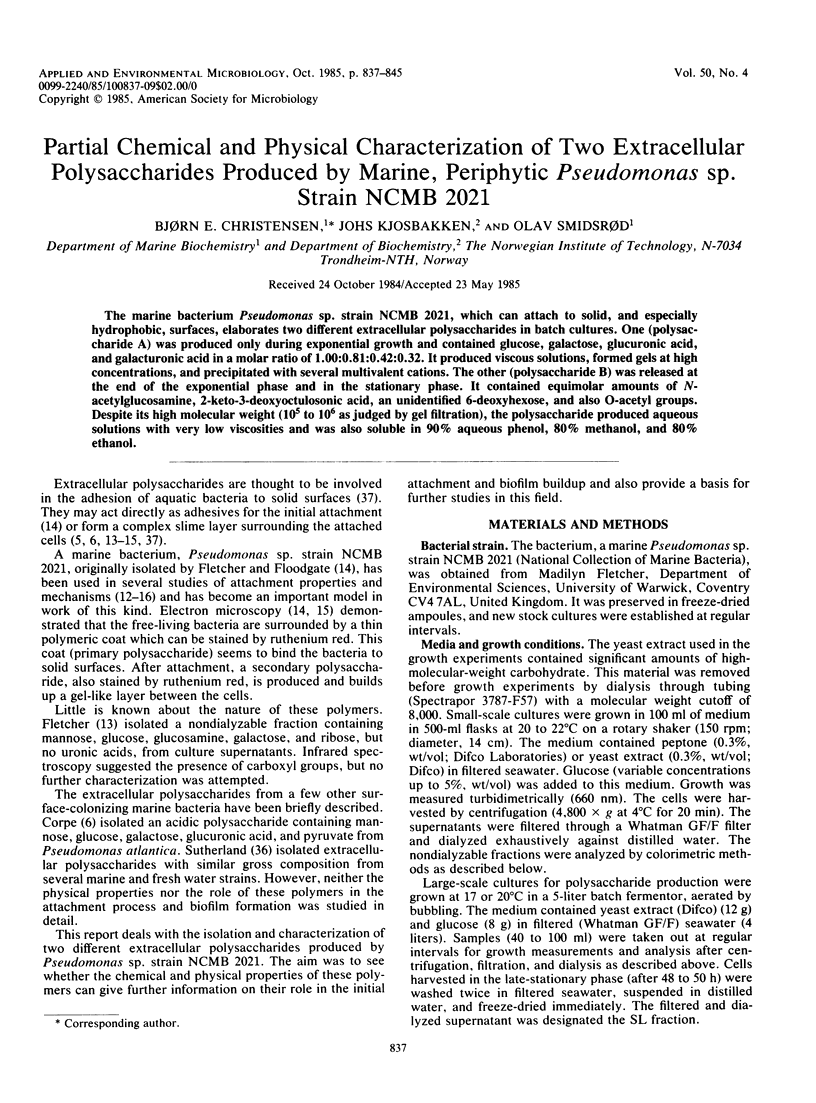
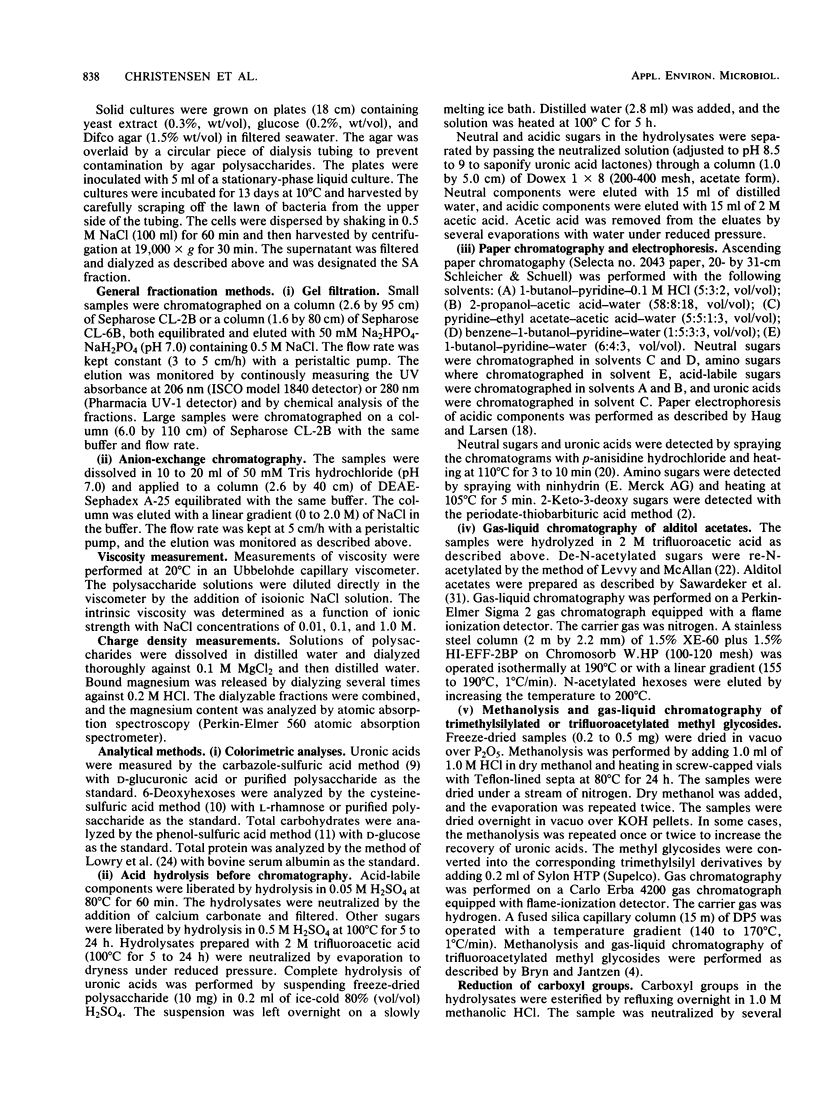
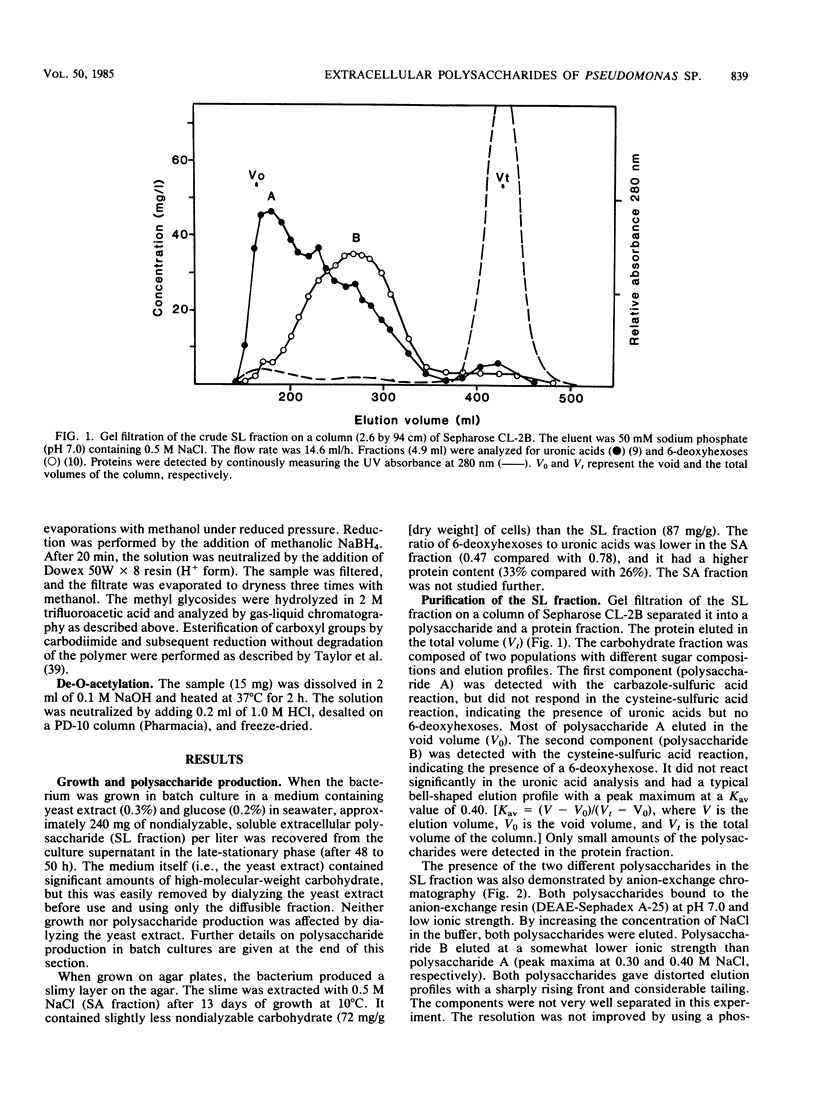
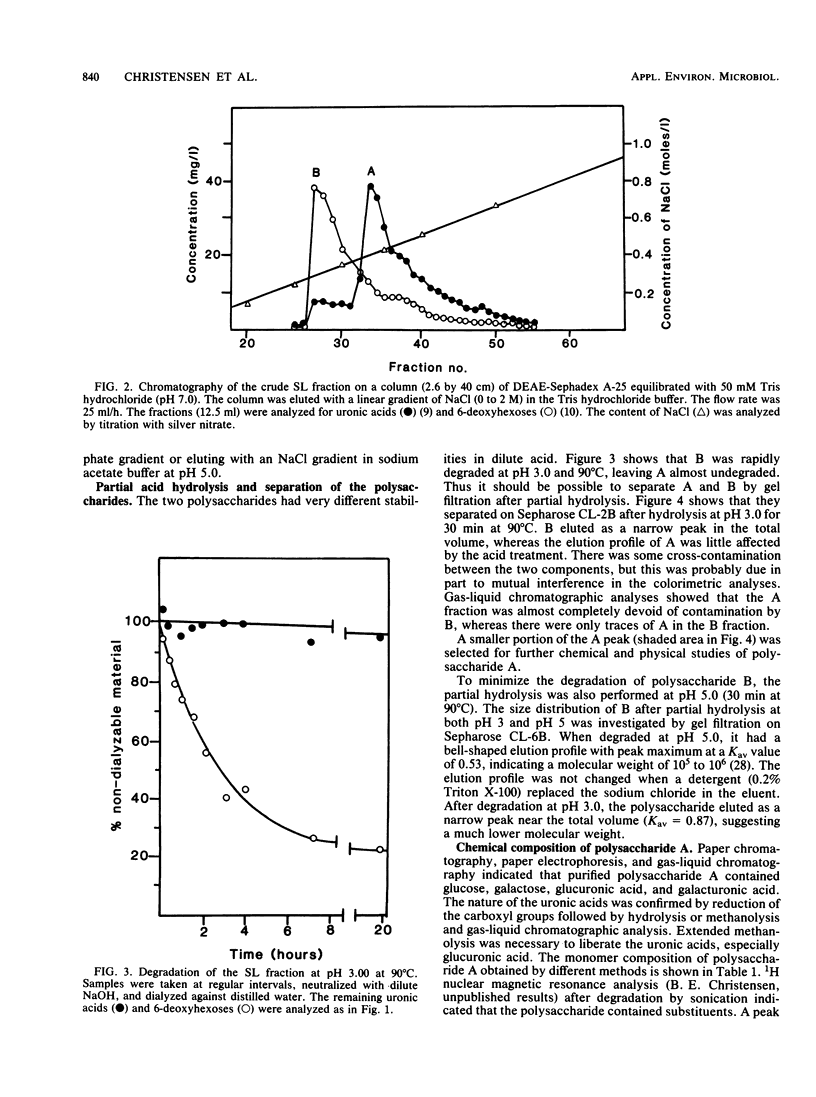
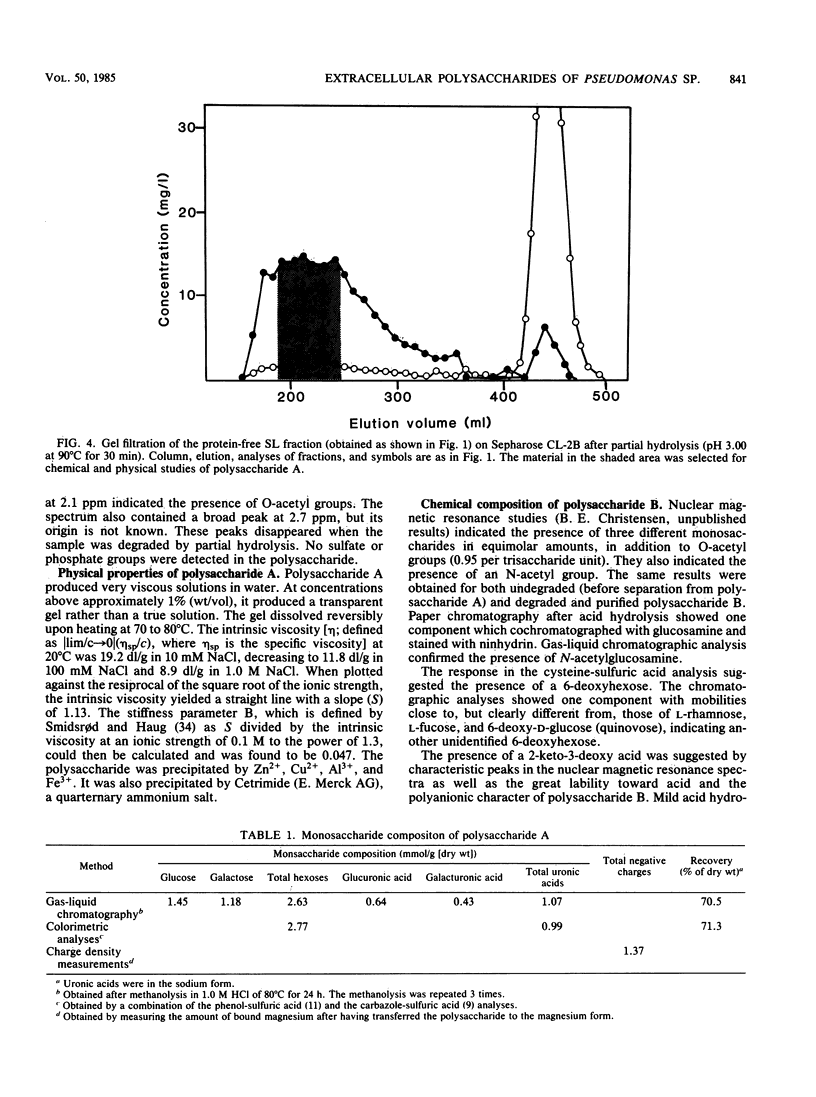

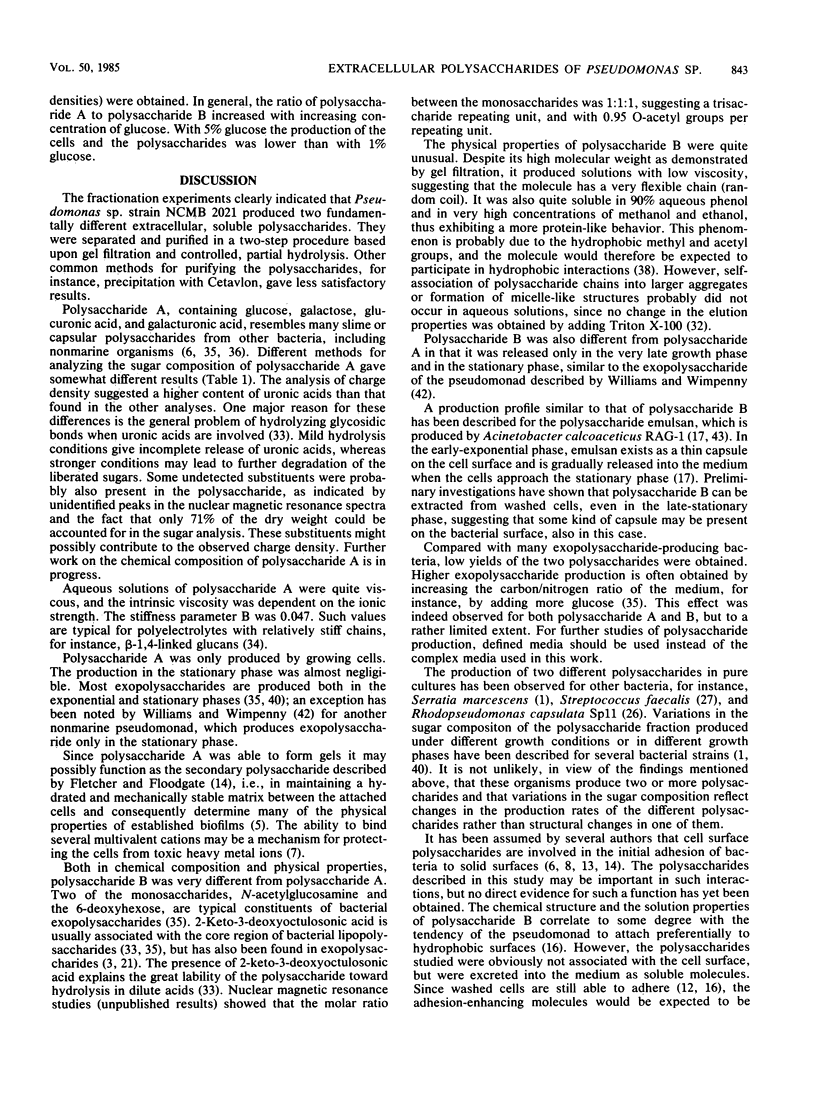
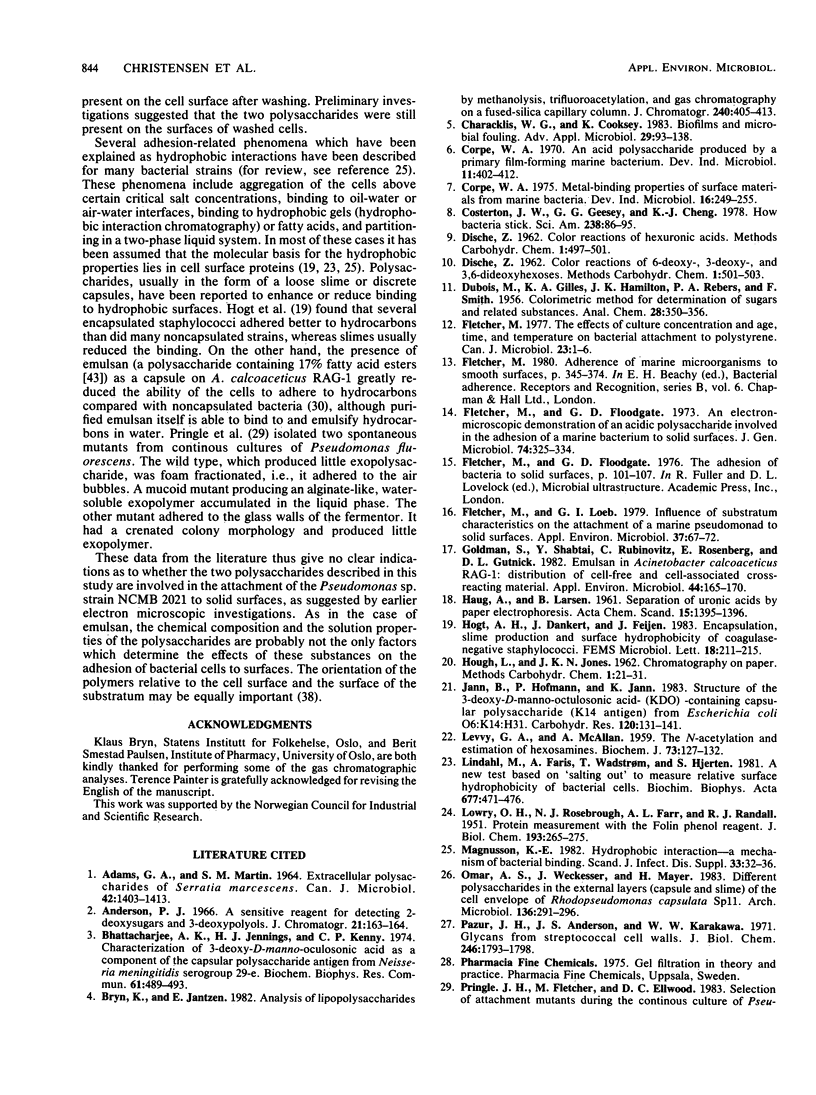
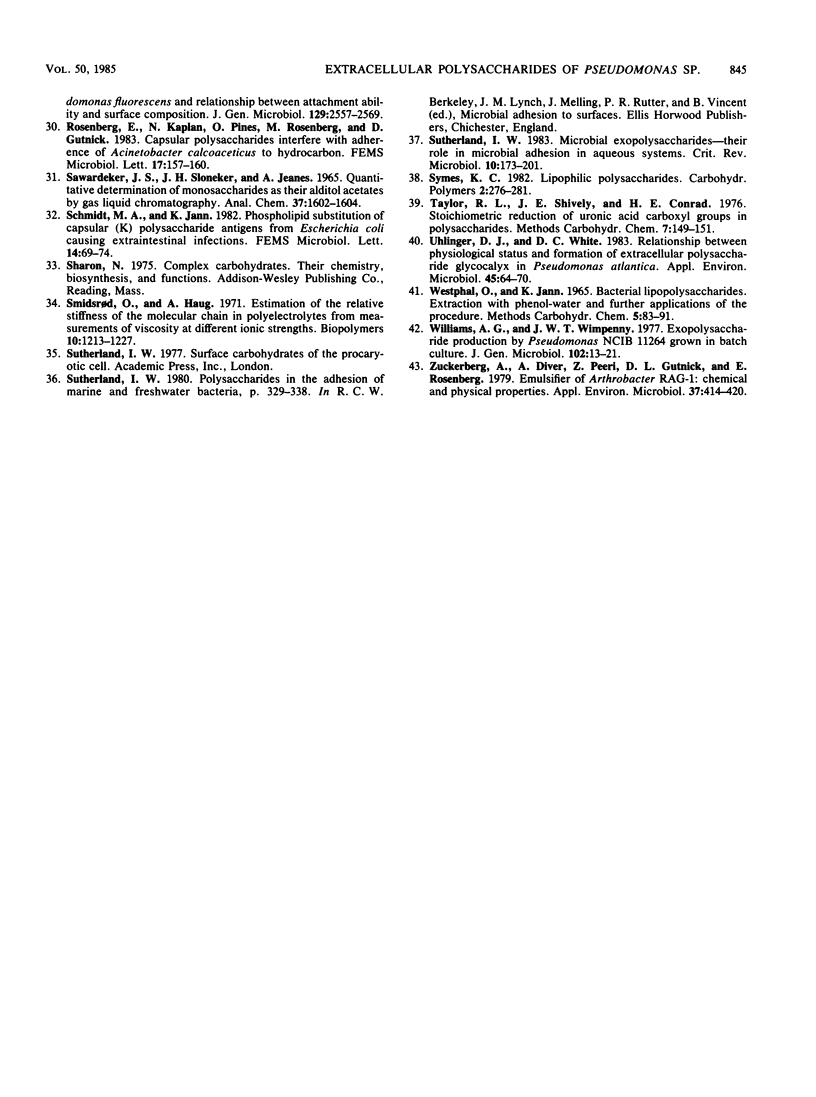
Selected References
These references are in PubMed. This may not be the complete list of references from this article.
- ADAMS G. A., MARTIN S. M. EXTRACELLULAR POLYSACCHARIDES OF SERRATIA MARCESCENS. Can J Biochem. 1964 Oct;42:1403–1413. doi: 10.1139/o64-152. [DOI] [PubMed] [Google Scholar]
- Anderson P. J. A sensitive reagent for detecting 2-deoxysugars and 3-deoxypolyols. J Chromatogr. 1966 Jan;21(1):163–164. doi: 10.1016/s0021-9673(01)91287-7. [DOI] [PubMed] [Google Scholar]
- Bhattacharjee A. K., Jennings H. J. Characterization of 3-deoxy-D-manno-octulosonic acid as a component of the capsular polysaccharide antigen from Neisseria meningitidis serogroup 29-e. Biochem Biophys Res Commun. 1974 Nov 27;61(2):489–493. doi: 10.1016/0006-291x(74)90983-8. [DOI] [PubMed] [Google Scholar]
- Costerton J. W., Geesey G. G., Cheng K. J. How bacteria stick. Sci Am. 1978 Jan;238(1):86–95. doi: 10.1038/scientificamerican0178-86. [DOI] [PubMed] [Google Scholar]
- Fletcher M., Loeb G. I. Influence of substratum characteristics on the attachment of a marine pseudomonad to solid surfaces. Appl Environ Microbiol. 1979 Jan;37(1):67–72. doi: 10.1128/aem.37.1.67-72.1979. [DOI] [PMC free article] [PubMed] [Google Scholar]
- Goldman S., Shabtai Y., Rubinovitz C., Rosenberg E., Gutnick D. L. Emulsan in Acinetobacter calcoaceticus RAG-1: Distribution of Cell-Free and Cell-Associated Cross-Reacting Material. Appl Environ Microbiol. 1982 Jul;44(1):165–170. doi: 10.1128/aem.44.1.165-170.1982. [DOI] [PMC free article] [PubMed] [Google Scholar]
- Jann B., Hofmann P., Jann K. Structure of the 3-deoxy-D-manno-octulosonic acid-(KDO)-containing capsular polysaccharide (K14 antigen) from Escherichia coli 06:K14:H31. Carbohydr Res. 1983 Aug 16;120:131–141. doi: 10.1016/0008-6215(83)88012-4. [DOI] [PubMed] [Google Scholar]
- Kelly T. E., Taylor H. A. Leucocyte values of alpha-L-iduronidase activity in mucopolysaccharidosis I. J Med Genet. 1976 Apr;13(2):149–151. doi: 10.1136/jmg.13.2.149. [DOI] [PMC free article] [PubMed] [Google Scholar]
- LEVVY G. A., MCALLAN A. The N-acetylation and estimation of hexosamines. Biochem J. 1959 Sep;73:127–132. doi: 10.1042/bj0730127. [DOI] [PMC free article] [PubMed] [Google Scholar]
- LOWRY O. H., ROSEBROUGH N. J., FARR A. L., RANDALL R. J. Protein measurement with the Folin phenol reagent. J Biol Chem. 1951 Nov;193(1):265–275. [PubMed] [Google Scholar]
- Lindahl M., Faris A., Wadström T., Hjertén S. A new test based on 'salting out' to measure relative surface hydrophobicity of bacterial cells. Biochim Biophys Acta. 1981 Nov 5;677(3-4):471–476. doi: 10.1016/0304-4165(81)90261-0. [DOI] [PubMed] [Google Scholar]
- Magnusson K. E. Hydrophobic interaction--a mechanism of bacterial binding. Scand J Infect Dis Suppl. 1982;33:32–36. [PubMed] [Google Scholar]
- Omar A. S., Weckesser J., Mayer H. Different polysaccharides in the external layers (capsule and slime) of the cell envelope of Rhodopseudomonas capsulata Sp11. Arch Microbiol. 1983 Dec;136(4):291–296. doi: 10.1007/BF00425219. [DOI] [PubMed] [Google Scholar]
- Pazur J. H., Anderson J. S., Karakawa W. W. Glycans from streptococcal cell walls. Immunological and chemical properties of a new diheteroglycan from Streptococcus faecalis. J Biol Chem. 1971 Mar 25;246(6):1793–1798. [PubMed] [Google Scholar]
- Smidsrod O., Haug A. Estimation of the relative stiffness of the molecular chain in polyelectrolytes from measurements of viscosity at different ionic strengths. Biopolymers. 1971;10(7):1213–1227. doi: 10.1002/bip.360100711. [DOI] [PubMed] [Google Scholar]
- Sutherland I. W. Microbial exopolysaccharides -- their role in microbial adhesion in aqueous systems. Crit Rev Microbiol. 1983;10(2):173–201. doi: 10.3109/10408418209113562. [DOI] [PubMed] [Google Scholar]
- Uhlinger D. J., White D. C. Relationship Between Physiological Status and Formation of Extracellular Polysaccharide Glycocalyx in Pseudomonas atlantica. Appl Environ Microbiol. 1983 Jan;45(1):64–70. doi: 10.1128/aem.45.1.64-70.1983. [DOI] [PMC free article] [PubMed] [Google Scholar]
- Williams A. G., Wimpenny J. W. Exopolysaccharide production by Pseudomonas NCIB11264 grown in batch culture. J Gen Microbiol. 1977 Sep;102(1):13–21. doi: 10.1099/00221287-102-1-13. [DOI] [PubMed] [Google Scholar]
- Zuckerberg A., Diver A., Peeri Z., Gutnick D. L., Rosenberg E. Emulsifier of Arthrobacter RAG-1: chemical and physical properties. Appl Environ Microbiol. 1979 Mar;37(3):414–420. doi: 10.1128/aem.37.3.414-420.1979. [DOI] [PMC free article] [PubMed] [Google Scholar]


